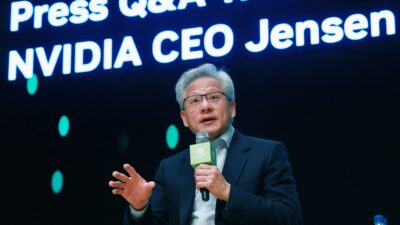IBM Joins Forces With AMD to Develop ‘Quantum-Centric Supercomputers’
McKinsey analysts forecast that quantum computing could unlock up to $1.3 trillion in economic value by 2035.

Sign up for smart news, insights, and analysis on the biggest financial stories of the day.
Seventy-two years ago, in 1953, IBM introduced the 650 Magnetic Drum Data Processing Machine, the world’s first mass-produced computer. The CPU, power unit and card reader weighed well over 4,000 pounds and could manage payrolls, perform statistical analyses and handle engineering design calculations, all things a 2.7-pound MacBook Air can handle in 2025.
On Tuesday, the elder statesman of America’s tech giants announced it will partner with semiconductor powerhouse AMD to jointly develop so-called “quantum-centric supercomputers” that can handle algorithms so complex they would make your MacBook go up in smoke at the coffee shop.
Algorithmic Promise
If you don’t know what quantum computing is — or if you’ve tried to understand it but ended up feeling like it’s 1977 and the Grateful Dead are on stage at Barton Hall and your head is spinning — here’s the basic idea. Quantum computing involves building super-powered computers that use tiny particles like atoms to perform lots of calculations at once, rather than one at a time. This means they can solve complex problems much faster than normal computers, which is why Amazon, Google, IBM and Microsoft are investing in the technology. Quantum computers will be able to solve incredibly complex statistical problems in finance, engineering, green tech and climate change, pharmaceuticals and more by processing data with previously unheard-of speed and complexity. As a result, technological progress will accelerate.
IBM’s partnership with AMD aims to combine quantum computing with high-performance computing, which involves the use of lots of computing power, like supercomputers, to solve problems that are too much for a normal computer on its own. IBM quantum computers will be integrated with the advanced computing power of AMD’s CPUs, GPUs and FPGAs so the two can be used together. IBM has an explanation for how it may be helpful:
- “For example, in the future, quantum computers could simulate the behavior of atoms and molecules, while classical supercomputers powered by AI could handle massive data analysis,” the company said in a statement. “Together, these technologies could tackle real-world problems at unprecedented speed and scale.”
- IBM said the hybrid approach could help in achieving its goal of creating “fault-tolerant” quantum computers by the end of this decade. Qubits, the unit of quantum information that quantum computers work with, are prone to errors because they are highly sensitive to environmental factors like noise and heat. “AMD technologies offer promise for providing real-time error correction capabilities, a key element of fault-tolerant quantum computing,” IBM said.
Simple Multiples: McKinsey analysts estimated earlier this year that quantum computing could generate as much as $72 billion in revenue by 2035, up from $4 billion last year. They also forecast that quantum computing could unlock up to $1.3 trillion in economic value in the automotive, chemicals, financial services and life sciences sectors by 2035. It doesn’t take a supercomputer or a MacBook to tell you that’s a lot of dough.











